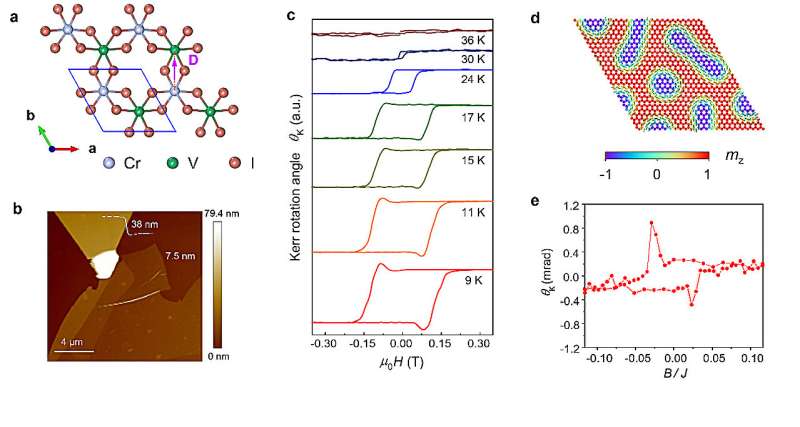This article has been reviewed according to Science X's editorial process and policies. Editors have highlighted the following attributes while ensuring the content's credibility:
fact-checked
peer-reviewed publication
proofread
Researchers discover 'topological Kerr effect' in two-dimensional quantum magnets

In a recent collaboration between the High Magnetic Field Center of the Hefei Institutes of Physical Science of Chinese Academy of Sciences, and the University of Science and Technology of China, researchers introduced the concept of the topological Kerr effect (TKE) by utilizing the low-temperature magnetic field microscopy system and magnetic force microscopy imaging system supported by the steady-state high magnetic field experimental facility.
The findings, published in Nature Physics, hold significant promise for advancing our understanding of topological magnetic structures.
Originating in particle physics, skyrmions represent unique topological excitations found in condensed matter magnetic materials. These structures, characterized by their vortex or ring-like arrangement of spins, possess non-trivial properties that make them potential candidates for next-generation magnetic storage and logic devices.
However, detecting skyrmions has traditionally relied on the topological Hall effect (THE), which is limited to metallic systems. With the expanding realm of topological magnetic materials, there's a pressing need for characterization techniques applicable to a broader range of systems, including non-metallic skyrmions.
Building on the discovery of two-dimensional ferromagnetic materials in 2017, the research team predicted a new class of such materials, CrMX6 (M=Mn, V; X=I, Br), which exhibit non-trivial topological electronic states.
In this study, the team successfully synthesized high-quality two-dimensional CrVI6 single crystals and conducted precise micro-area magneto-optical Kerr effect (MOKE) measurements. Remarkably, the MOKE hysteresis loop revealed distinctive "cat ear"-shaped prominences within specific thickness ranges and temperature intervals, resembling the electrical topological Hall effect observed in magnetic skyrmion systems.
Further theoretical analysis revealed that the coexistence of Cr and V atoms breaks central inversion symmetry, the strong Dzyaloshinskii-Moriya (DM) exchange leading to the generation of topological magnetic structures—skyrmions.
Atomic-scale magnetic dynamics simulations and theoretical calculations unveiled the scattering of conducting electrons by the "topological charge" of skyrmions under a photoelectric field, elucidating the microscopic mechanism behind the optical Kerr signal during magnetization reversal.
Based on these findings, the research team proposed a new scheme for non-destructive detection of topological magnetic structures using optical methods, leveraging alternating photoelectric fields and high magnetic field spectroscopy.
This scheme offers spatially resolved, non-contact detection of skyrmions and other topological excitations, providing valuable insights into their microscopic mechanisms and broadening their application range, according to the team.
More information: Xiaoyin Li et al, Topological Kerr effects in two-dimensional magnets with broken inversion symmetry, Nature Physics (2024). DOI: 10.1038/s41567-024-02465-5
Journal information: Nature Physics
Provided by Hefei Institutes of Physical Science, Chinese Academy of Sciences





















